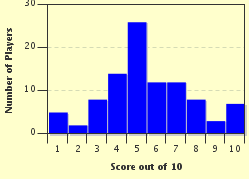Quiz Answer Key and Fun Facts
1. Which is the largest lake in the world?
2. A reservoir, as the name implies, is water held in reserve by a reservoir so it can serve a particular purpose. Which is the largest reservoir in the world?
3. Which is the longest river in Europe?
4. The term "The Seven Seas" is believed to have first appeared in 2,300 BC. Which one of these seas was not one of "The Seven Seas" named by the ancient Greeks?
5. Which body of water has its deepest point as the Sunda Trench?
6. At a height of 770 ft (235 m) which was the tallest dam in the United States when it was completed in 1968?
7. An oxbow lake is an isolated pond of water left behind after a river changes course and is cut off to form a lake. What is the name given to these oxbow lakes in Australia?
8. What is meant by brackish water?
9. It's all water in one state or another, but what claim to fame does the state of Meghalaya, India, have?
10. A swamp is a wetland that is forested, and the two categories are either swamp forests or shrub swamps. Which is the largest swamp in North America?
Source: Author
zambesi
This quiz was reviewed by FunTrivia editor
Tizzabelle before going online.
Any errors found in FunTrivia content are routinely corrected through our feedback system.


